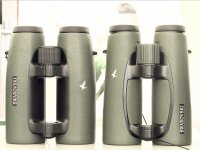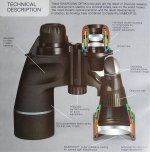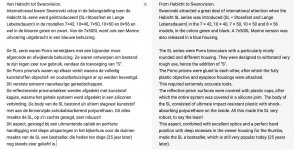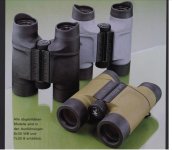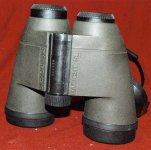Although Tom has asked an obvious and simple question, I don’t think that there is a completely clear answer!
While Swarovski’s letter designations for models were once abbreviations for significant features (e.g. with the SL and SLC binoculars, which I discuss below),
I don’t think this is necessarily still the case
For example, in current usage, the letter ‘L’ seems to be used primarily for branding consistency
It in effect indicates a Swarovski binocular verses either another Swarovski product line, or another brand of binocular
i.e. the obvious continuity of SL, SLC, EL, EL Range, CL Companion (x30) and CL Pocket (x25)
Swarovski also shows remarkable branding consistency when new designs are introduced:
- the EL Swarovsion of 2009 (radically new optics, similar body but differing in mechanical detail - see the attached image, especially re the hinges * )
- the SLC HD of 2010 (all new optics, mechanics, housing and covering)
- the new CL x30 of 2017 (new optics, body and covering)
Clearly an important component of Swarovski marketing is the stress on the continuity of it’s offerings i.e. building upon established favourable associations, including model names
* the image is from:
http://www.fjbirds.org/bbs/viewthread.php?tid=16106 (however, the link has broken)
SL DESIGNATION
The SL was introduced in 1980, and essentially used the glass of the traditional Porro series binoculars (which are still in production), in a radical new housing
The SL made use of both sophisticated and complex assembly techniques, and then enclosed the plastic body shell components in a softer external covering
See the attached cross section (per Henry Link at:
https://www.birdforum.net/showpost.php?p=2692087&postcount=67 )
It seems that SL stands for ‘Stossfest en Lange Lebensdauer’, which translates into English along the lines of ‘shockproof and long life’
This information is from Jan van Daalen’s, House of Outdoor site. See the page ‘Historie of Swarovski’:
https://www.swarovskiverrekijkers.com/historie/
(I’m unsure if this information originates from Jan or from Gijs van Ginkel)
For convenience I’ve attached a Google translation of both the relevant section from the Dutch, and a translation of the specific phrase from the German
SLC DESIGNATION
Swarovski introduced their first roof prism binocular, the 8x30 W SLC in 1985. It used a different but similarly complex construction to that of the SL
And it’s original external styling was obviously modelled on that of the SL Porros
- see the image attached to the next post (it's from Gij’s, History of Swarovski:
https://www.houseofoutdoor.com/verrekijkers/verrekijkers-testen-en-vergelijken/ )
The C indicated that this was the ‘SL Compact’ version - and certainly the x30 SLC was much more compact than the x42 and larger Porro SL’s
And similarly, the later x42, x50 and x56 models were relatively more compact than their SL Porro prism counterparts
EL DESIGNATION
The original EL was introduced in 1999, and it’s still possible to access Swarovski’s web pages from that time, via Wayback:
http://web.archive.org/web/20001002040444/http://www.swarovskioptik.com/nf/us/hunting/el.htm
However, neither the initial EL page or the other pages such as Product Advantages, state specifically what EL stands for
In the ‘Historie of Swarovski’ that I’ve linked to above, the EL is referred to as ‘Extra Lite’ (see the entry for 1999), which is presumedly referring to the use of magnesium in the construction
However, the most obvious - and then both unique and radical - characteristic of the EL, was of course it’s physical design, which would suggest E is for ‘Ergonomic’
CL DESIGNATION
The CL Companion was introduced in 2011. A 2012 catalogue which first describes the model has no reference as to what the C indicates (nor the SLC or EL designations)
Perhaps C for ‘Compact’, especially verses its 8x32 EL counterpart?
So that’s about all I’ve got!
If anyone does have more specific information, I’d certainly be interested in it
John






